Walking about your home only to find your cat’s litter spread all around the household? It’s time you need to know how can you stop your cat from getting litter everywhere.
Imagine having to enter the house after a long day only to walk on a carpet of cat litter! While the feeling is certainly nerve-racking, it might make you wonder why your cat does it?
Having a litter box with a cat as your pet is quite essential but what if you find the litter everywhere around your floor and carpet? How can you stop your cat from getting litter everywhere?
We help you fix the dilemma by suggesting a number of techniques you can try to stop your cat from getting litter everywhere and keeping your house and floorings clean.
Why Is My Cat Getting Litter Everywhere?
Cats dig excessively for burying their waste and sheddings under the litter. This usually causes the litter to get everywhere outside the litter box.
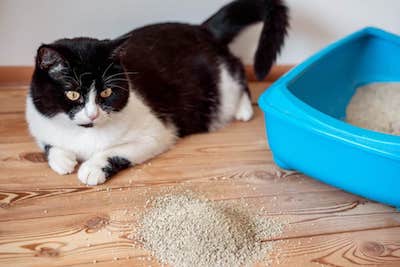
Cats are total neatness freaks and they like to keep their house and surroundings clean. They usually have a tendency of hiding their poop by digging it deep into the litter.
At times, they may get too enthusiastic and start digging to the center of the earth or feel like they are on a treasure hunt. That’s when the litter starts kicking out.
If the walls of the litter box are not too high, it is obvious for the litter to start falling out due to extensive digging. After all, all litter boxes are not made to understand a cat’s natural digging instincts right?
Cats may also dig aggressively due to some underlying stress or anxiety or out of plain boredom. Litter everywhere around the house is not a good sign, as dirty litter can be unhygienic. Moreover, it may cause allergies or respiratory disorders and increase your efforts of cleaning the house.
How Can I Stop My Cat From Getting Litter Everywhere?
Considering their litter box and fixing the problems associated with their box is one of the best ways to stop getting litter everywhere around the house.
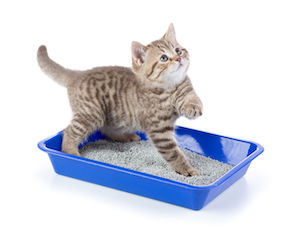
There is not much that can be done about changing your cat’s habits. However, here are some ideas you can consider to stop your cat from getting litter everywhere around the house.
Type of Litter Box
If you notice litter everywhere around the house, maybe it’s time you need to consider a different type of litter box for your kitty. A few types to consider are given below.
Are you willing to know more about 101of cat litter types click here to know more?
Big Sized Litter Box
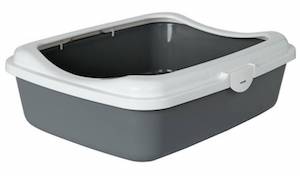
After their shedding business, if your cats do not find enough space to bury their litter, they can end up kicking the litter out of the box to make some space. They also need a place in the box to sit and carry out their activities comfortably.
Therefore, providing them with enough room in the box is a must so that the litter stays inside the box and is not kicked out easily even if your cat digs extensively.
Litter Box with Tracker Trap
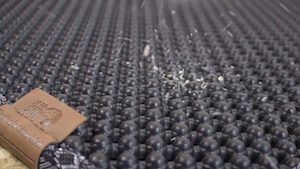
Litter boxes with built-in or externally designed tracker traps are a win-win if litter tracking is the issue you face. These tracker traps are placed in such a way outside the litter box that each time your cat steps out of the box, he is not carrying oodles of litter around on its paws.
Tracker traps will help keep your flooring and precious carpets clean and away from cat litter as most of it gets stuck on the tracker trap attached to the litter box.
Covered Litter Box
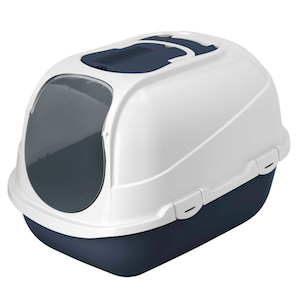
Covered litter boxes have an enclosed space so your cat will not be able to kick high amounts of litter outside the box. However, these boxes usually have a front opening and if your cat is smart enough, he may want to throw the litter out, from the front entry.
Usually, these boxes have high walls to prevent the contents of the box from falling out. Covered litter boxes can have their own disadvantages as they end up retaining the odor for a long and are not very ventilated.
Try using a covered litter box for your cat and check his response. If he feels uncomfortable, then you need to try something else!
Box Inside Box
If your litter box does not support preventing litter tracking, then a box inside a box is an idea worth considering. It can be any box, be it plastic, cardboard, etc. Just place a smaller litter box inside the bigger box.
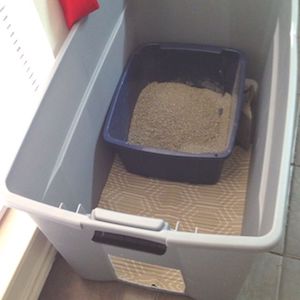
This especially works if your cat’s litter box is not ‘litter leakproof’ and can be used as a protective measure. So each time your cat is up for excavation, the litter falls within the confined zone and not outside the box.
Top Entry Box
Top entry boxes are quite effective in preventing litter from falling off the box as they have a high walled design. This stops the litter from coming out of the box unless your cat decides to throw the litter up in the air and gets extra playful.
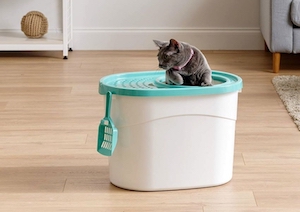
If your cat is old, arthritic, or too tiny, you may want to consider getting a top entry litter box as they may find it inconvenient to jump or enter inside it.
Scoop Daily
It is important to scoop the litter at least once or twice daily in order for your cat to avoid kicking out the litter. This also helps in maintaining the litter box and keeping it clean for your cat to use each time.
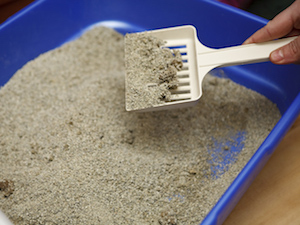
Cats like to keep their areas clean. Dirty litter lingering around in the box only leads to a dirty odor and creates an unpleasant environment for your cat.
Therefore, if they find a clump of dirty litter around the box, they may start digging or throwing most of the litter out of the box to make space for their activities.
Change the Type of Litter

If your cat does not like the litter, he kicks it out of the box. Maybe, it’s time to change the type of litter. Cats have preferences when it comes to choosing litter that is conducive to their digging and burrowing.
If they are not being able to adjust to the type of litter in the box, you need to experiment with different types until your cat takes a liking to a particular variety and consistency of litter.
There are various types of litter available, common ones being the clumping and the non-clumping type.
- Clumping Litter: This type of litter is made of bentonite and the texture suits your cat’s paws just right.
Clumping litter feels like clay, they are very fine and absorbent, controls odor, and forms clumps easily when your cat urinates. This makes it easy to scoop. However, they are too heavy to replace each time and are non-biodegradable.
- Non-Clumping Litter: Any type of litter made apart from clay material is non-clumping litter. This can include wheatgrass, pine, paper, silicon gel, etc. Sometimes, these are available as large pellets so it becomes difficult for your cat to throw or track it out of the box.
Try out the new lightweight cat litter available on the market.
Place a Mat Under the Litter Box
Mats are a protective way to keep the litter from getting everywhere outside the box. Your cat may move in and out of the litter pan several times a day which may lead to scattering of litter around the house, your carpets, and flooring.
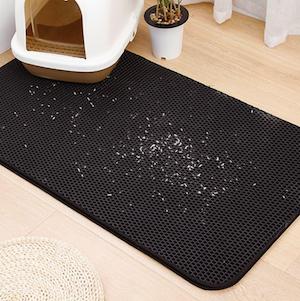
Placing a scatter mat around the litter box will keep litter from sticking to your cat’s paws and trap it on the mat. Therefore, your cat will not be able to spread litter everywhere while he moves in and out of the box.
Get a Broom and Hand Vacuum
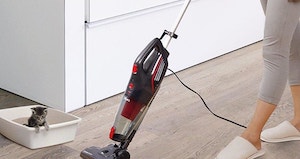
If you have a pet at home, then a vacuum cleaner and a broom form the basic essentials of cleaning.
Every time you see any waste or litter scattered, take a few minutes to use the vacuum cleaner or broom around that area to sweep the dust off the floor. This will prevent the litter from spreading to other areas of the house and keep it clean.
Keep the Paws Pretty!
Often the hair and fur around your cat’s paws can have litter stuck in the nooks and insides of the hair. That is why you need to keep the hair trim and the fur tiny.
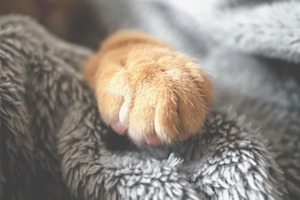
Especially if your cat is a hairy furball and uses the litter box, they may end up having some litter stuck to their paws which would eventually stick and spread everywhere around the house.
Therefore, keep their fur small and trim their nails often, to not have any unwanted litter walking about with your cat on your flooring and carpets.
Check the Litter Level in Box
Ideally, the appropriate level of litter in the box should be 2 to 2.5 inches. If the litter box is high walled, consider filling it with 4 to 4.5 inches of litter for your cat to indulge in deeper digging and burrowing.

Do not let the box overflowing with litter. Digging their waste is part of a cat’s natural habitat and therefore would require an optimum level of litter for regular burrowing. If the box is full up to the brim, some litter is bound to spill off the box on the outsides.
Fill it to a minimum level, and if your cat is not satisfied, increase the level a little by making sure they are not spilling or kicking the litter out of the box.
You should check out the best catlitter for urine.
Toilet Train Your Cat
If you are tired of cleaning litter every time around the house, then you can always toilet train your kitty. There are special training tools like toilet seat attachments and accessories available that ensure your cat uses the toilet seat comfortably.
If your cat is not too small or too old, then he can definitely climb the toilet seat and be trained.
However, litter box training your cat will require a lot of patience and need you to invest a lot of time. If time and patience is not your thing, stick to the litter box for your kitty.
Cat Litter Everywhere | Use Litter Box Enclosures
If you have tried everything to stop your cat from getting litter everywhere, and still cleaning litter around the house, then it’s time you use a litter box enclosure.
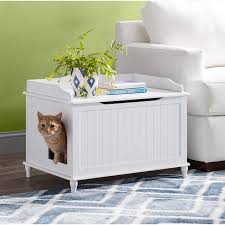
These enclosures are made specifically to keep the litter box secured within a box or a piece of furniture to avoid mess and odor and to provide a separate space for your cat to poo and pee.
Litter Box Enclosures can either be a cabinet made of plastic or wood or appear like a shelf with the box kept inside. They are quite ventilated and provide a seclusive room for your cat amidst all the hustle and bustle in the house.
If you have no limits to space at your home, you can purchase a large, ventilated cabinet that matches with the furniture of your house. It should have comfortable entry points for your cat to access the box easily and carry out its business at peace without getting any litter around and about the house.
For those who have a space crunch at their house, you can still have a litter box enclosure and keep all the dirt and litter at bay, enclosed within the box.
Here are a few steps where you can get crafty and make your own litter box enclosure:
- Measure your cat’s dimensions and the amount of space it would require for entry or exit.
- You can use scrap cardboard or white foam pieces to make an enclosure. Make sure to make a separate flap door for easy access to the box.
- Keep some extra cardboard at the bottom to make the legs of the litter box stall.
- Connect all the cardboard pieces together with extra cardboard strips and glue. Allow the glue to dry.
- Stand up the 3 panels once done and make the stall.
- Leave the door ajar for your cat to enter and exit the stall easily.
- Make sure to keep it ventilated for the dirty odor to fade away from the box quickly and for your cat to not feel suffocated.
- Use some stickers and graffiti to make it more appealing and attractive for your cat.
Some cats may not like the idea of using litter boxes in an enclosed space. They can have issues in accessing the litter box, or in moving in and out of the box, or they may simply feel suffocated.
These litter boxes may not get rid of the odor quite easily if they do not have sufficient openings and hence cats may not prefer them.
You may have to experiment for a few weeks before you figure out what suits your cat best and clean the waste and litter accordingly.
Final Note
Being a cat parent comes with its own consequences. This includes having to clean litter everywhere around the house. Cats have natural instincts and tendencies of burrowing and hiding their poop. This makes them dig into the litter and spilling contents out of the box.
While you cannot do much to change their habits and stop your cat from getting litter everywhere, we can definitely take the measures suggested above to prevent the litter from spreading in your house.
With our quick and easy to fix techniques, you can stop your cat from getting litter everywhere.
After all, the litter needs to stay inside the litter box, not out of the box!!
FAQs
Why do cats dig in the litter?
Cats dig in the litter in order to hide their urine and feces. They like to keep their surroundings neat and hence bury their sheddings beneath the litter. This is why they dig excessively in the box which is a part of their natural instincts.
How to keep cat litter off the floor?
In order to keep cat litter off the floor, you can use litter tracking traps or mats and place them around or below the litter pan. This allows trapping the litter on the mat each time your cat steps in and out of the litter box.
Is there a non-tracking cat litter?
Usually, the clumping type of cat litter is non-tracking due to its texture and ability to form clumps easily each time your cat does its shedding business. The clumping property does not allow it to spread or track any further from outside the box.
How to get a cat to quit throwing litter everywhere?
Distract your cat with a loud sound or toy to avoid him from digging excessively and getting the litter everywhere. Offer a treat to train them to not burrow and dig aggressively. Training them to quit throwing litter everywhere may take time and requires patience.
Which type of litter box is best to avoid litter from getting everywhere?
Litter boxes with built-in trackpads and high walled litter boxes with a top entry are the best type of box to avoid getting litter from going everywhere.
These boxes can trap the litter from your cat’s feet or avoid the litter from escaping outside the litter box which will help keep your floorings and house clean.

